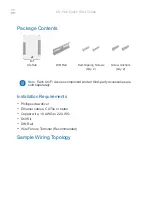Modular Input/Output Subsystem (MIOS14)
MPC561/MPC563 Reference Manual, Rev. 1.2
Freescale Semiconductor
17-65
NOTE
If a submodule in a group of 16 cannot generate interrupts, then its
corresponding flag bit in the status register is inactive and is read as zero.
When an event occurs in a submodule that activates a flag line, the corresponding flag bit in the status
register is set. The status register is read/write, but a flag bit can be reset only if it has previously been read
as a one. Writing a “one” to a flag bit has no effect. When the software intends to clear only one flag bit
within a status register, the software must write an all-ones 16-bit value except for the bit position to be
cleared which is a zero.
The enable register is initialized by the software to indicate whether each interrupt request is enabled for
the levels defined in the ICS.
NOTE
In the case of multiple requests levels implementation in the same MIOS14,
it is possible to enable interrupts at more than one different levels for the
same submodule. It is the responsibility of the software to manage this.
Each bit in the IRQ pending register is the result of a logical “AND” between the corresponding bits in the
status and in the enable registers. If a flag bit is set and the level enable bit is also set, then the IRQ pending
bit is set, and the information is transferred to the interrupt control section that is in charge of sending the
corresponding level to the CPU. The IRQ pending register is read only.
NOTE
When the enable bit is not set for a particular submodule, the corresponding
status register bit is still set when the corresponding flag is set. This allows
the traditional software approach of polling the flag bits to see which ones
are set. The status register makes flag polling easy, since up to 16 flag bits
are contained in one register.
The submodule number of an interrupting source defines the corresponding MIRSM number and the bit
position in the status registers. To find the MIRSM number and bit position of an interrupting source,
proceed as follow:
1. Divide the interrupting submodule number by 16
2. The integer result of the division gives the MIRSM number
3. The reminder of the division gives the bit position
17.12.3 MIRSM0 Interrupt Registers
17.12.3.1 Interrupt Status Register (MIOS14SR0)
This register contains the flag bits that are raised when the submodules generate an interrupt. Each bit
corresponds to a given submodule.
Summary of Contents for MPC561
Page 84: ...MPC561 MPC563 Reference Manual Rev 1 2 lxxxiv Freescale Semiconductor...
Page 144: ...Signal Descriptions MPC561 MPC563 Reference Manual Rev 1 2 2 46 Freescale Semiconductor...
Page 206: ...Central Processing Unit MPC561 MPC563 Reference Manual Rev 1 2 3 62 Freescale Semiconductor...
Page 302: ...Reset MPC561 MPC563 Reference Manual Rev 1 2 7 14 Freescale Semiconductor...
Page 854: ...Time Processor Unit 3 MPC561 MPC563 Reference Manual Rev 1 2 19 24 Freescale Semiconductor...
Page 968: ...Development Support MPC561 MPC563 Reference Manual Rev 1 2 23 54 Freescale Semiconductor...
Page 1144: ...Internal Memory Map MPC561 MPC563 Reference Manual Rev 1 2 B 34 Freescale Semiconductor...
Page 1212: ...TPU3 ROM Functions MPC561 MPC563 Reference Manual Rev 1 2 D 60 Freescale Semiconductor...
Page 1216: ...Memory Access Timing MPC561 MPC563 Reference Manual Rev 1 2 E 4 Freescale Semiconductor...


















